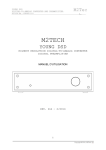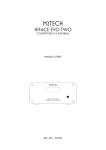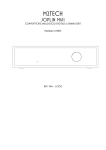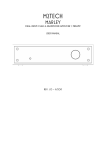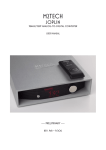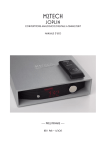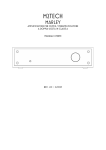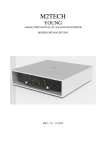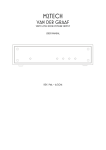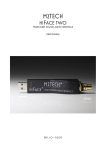Download M2TECH YOUNG User manual
Transcript
M2TECH YOUNG DSD HIGHEST RESOLUTION DIGITAL-TO-ANALOG CONVERTER DIGITAL PREAMPLIFIER USER MANUAL REV. 1.1 – 3/2014 YOUNG DSD DIGITAL-TO-ANALOG CONVERTER AND PREAMPLIFIER M2Tech www.m2tech.biz REVISION 1.1 – march 2014 Copyright © 2014, M2Tech Srl 2 YOUNG DSD DIGITAL-TO-ANALOG CONVERTER AND PREAMPLIFIER M2Tech www.m2tech.biz REVISION 1.1 – march 2014 Warning! Changes or modifications not authorized by the manufacturer can invalidate the compliance to CE regulations and cause the unit to be no more suitable to use. The manufacturer refuses every responsibility regarding damages to people or things due to the use of a unit which has been subject to unauthorized modifications or to misuse or to malfunction of a unit which has been subject to unauthorized modifications. This unit is compliant with the following CE regulations: CEI EN 55022:2009 Class B (Radiated Emissions), CEI EN 55024:1999, CEI EN 55024:A2/2003, CEI EN 55024:IS1/2008 (Radio Frequency Electromagnetic Fields, 50Hz Magnetic Field Immunity Test and Electrostatic Discharges – ESD). For a proper operation of this unit, all connections to other equipment in the system must be done when all equipment are off. Failing to comply with this advice may lead to damage to the Young DSD. Copyright © 2014, M2Tech Srl 3 YOUNG DSD DIGITAL-TO-ANALOG CONVERTER AND PREAMPLIFIER M2Tech www.m2tech.biz REVISION 1.1 – march 2014 The label above, printed on the product case, indicates that the product, when no more usable, can’t be treated as generic garbage, but must be disposed of at a collection point for recycling of electrical and electronic equipment, in compliance with the WEEE regulation (Waste of Electrical and Electronic Equipment). By making sure that this unit is correctly recycled, you will help preventing potential damages to environment and human health, which could be caused by a wrong treatment of this product as generic garbage. Materials’ recycling helps saving natural resources. For more in-depth information about recycling this product, please contact M2Tech Srl. WARNING: the information contained in this manual are considered to be reliable and accurate. M2Tech reserves the right to change or modify the information any time, without prior advice. It’s up to the customer to ensure that the manual being consulted is the latest version. Copyright © 2014, M2Tech Srl 4 YOUNG DSD DIGITAL-TO-ANALOG CONVERTER AND PREAMPLIFIER M2Tech www.m2tech.biz REVISION 1.1 – march 2014 Dear customer, Thank you for purchasing YOUNG DSD. You are the owner of a very high quality digital-to-analog converter with many unique features designed to obtain the best performance in every hi-fi system. YOUNG DSD implements a specific set of technological and functional solutions, from the asynchronous USB interface to passive anti-alias filtering, to offset recovery right on I-to-V converters to the ability of delivering a high output level with the purpose of exalting sonic performances, ease of use and reliability. Moreover, YOUNG DSD shares many features with preamplifiers, therefore it is recommended to directly drive power amplifiers YOUNG DSD is provided with a complete set of inputs, to allow for using every kind of digital source. The balanced output and the stock adaptors for single-ended connection allow for driving every kind of amplifier. The ability of setting the maximum output level to two values ensures that the maximum power will be reached even with the most inefficient tube amplifier whenever the YOUNG DSD is used as a preamplifier. The fully-loaded remote control allows for total control of both YOUNG DSD and most audio players running on the computer attached to its USB input We’re sure that your expectations will be fulfilled by purchasing YOUNG DSD: you’ll hear your favourite music as never before, so you can now prepare for a whole new listening experience! Nadia Marino, CEO Please note here your YOUNG DSD serial number and purchase info for future reference: S/N: _______________________ Date of Purchase: _________________________ Place of Purchase__________________________ Note: Proof of retail purchase, such as your purchase receipt, will be required in the unlikely event that any warranty service will be required Copyright © 2014, M2Tech Srl 5 YOUNG DSD DIGITAL-TO-ANALOG CONVERTER AND PREAMPLIFIER M2Tech www.m2tech.biz REVISION 1.1 – march 2014 Copyright © 2014, M2Tech Srl 6 YOUNG DSD DIGITAL-TO-ANALOG CONVERTER AND PREAMPLIFIER M2Tech www.m2tech.biz REVISION 1.1 – march 2014 TABLE OF CONTENTS 1. Unpacking and Placing the Unit.............................................................................. 9 2. Front Panel ........................................................................................................... 11 3. Back Panel............................................................................................................ 13 4. Remote Control..................................................................................................... 15 5. Connecting and Powering the Unit ....................................................................... 17 6. Cleaning the Unit .................................................................................................. 19 7. Using the Young DSD........................................................................................... 21 7.1. Volume Setting ............................................................................................... 22 7.2. Mute Toggle ................................................................................................... 22 7.3. Choosing the Signal’s Phase ......................................................................... 23 7.4. Source Selection ............................................................................................ 23 7.5. Menu Navigation ............................................................................................ 24 7.6. Balance Setting .............................................................................................. 25 7.7. Choosing the Maximum Output Level ............................................................ 26 7.8. Setting the Display’s Backlight Intensity ......................................................... 27 7.9. Choosing Volume Mode ................................................................................. 28 7.10. Setting the Automatic Switch Off .................................................................. 29 7.11. Checking Firmware Revision........................................................................ 30 7.12. Power Off and Standby ................................................................................ 30 8. Using a Computer as Digital Source ..................................................................... 33 8.1. Plug’n’Play Operation with Apple OSX........................................................... 33 8.1.1. DSD files playback with Mac.................................................................... 37 8.2. Plug’n’Play Operation with Linux .................................................................... 39 8.2.1. DSD files playback with Linux.................................................................. 42 8.3. Using the Young DSD with Windows ............................................................. 42 8.3.1. Installing the Windows driver ................................................................... 43 8.3.2. Windows driver uninstall .......................................................................... 54 Copyright © 2014, M2Tech Srl 7 YOUNG DSD DIGITAL-TO-ANALOG CONVERTER AND PREAMPLIFIER M2Tech www.m2tech.biz REVISION 1.1 – march 2014 8.3.3. Windows Driver Panel ............................................................................. 61 8.3.4. Using the YOUNG DSD as Windows predefined audio device................ 70 8.3.5. Configuring the player: FooBar and JRiver Media Center ....................... 72 8.3.6. Connecting the YOUNG DSD to an USB 1.1 port.................................... 81 9. Controlling the Computer Player by Using the Young DSD Remote Control ........ 83 10. Updating Young DSD Firmware.......................................................................... 85 11. Specifications...................................................................................................... 87 Copyright © 2014, M2Tech Srl 8 M2Tech YOUNG DSD DIGITAL-TO-ANALOG CONVERTER AND PREAMPLIFIER www.m2tech.biz REVISION 1.1 – march 2014 1. Unpacking and Placing the Unit Lay the box on a table and open it by separating it from the external paperwork and removing or cutting the adhesive tape seal. The following items are included: • • • • • • one YOUNG DSD; one wall wart (AC-to-DC adapter); one USB A-B cable; two XLR-RCA high quality adaptors; one remote control; this manual. Should one or more item be missing, please contact your retail dealer. Remove the YOUNG DSD from the foam enclosure and place it onto a stable base, far from heat sources. Avoid full sunlight on the unit. Allow for ample room around the unit for venting. The YOUNG DSD is a high efficiency device; therefore it doesn’t produce relevant heat during its operation. Regardless, it’s recommended to guarantee an adequate air flow around the unit. Moreover, every time it will mainly be operated by remote control, it’s recommended to place it so as the remote control’s infrared signals can easily reach its front panel. Avoid smoke, moisture, dirt and liquids from reaching the unit. Please note that any signs of abuse will void warranty coverage. Copyright © 2014, M2Tech Srl 9 YOUNG DSD DIGITAL-TO-ANALOG CONVERTER AND PREAMPLIFIER M2Tech www.m2tech.biz REVISION 1.1 – march 2014 Do not place the unit on thick carpets or inside a box or piece of furniture, not even close to curtains. Copyright © 2014, M2Tech Srl 10 YOUNG DSD DIGITAL-TO-ANALOG CONVERTER AND PREAMPLIFIER M2Tech www.m2tech.biz REVISION 1.1 – march 2014 2. Front Panel Figure 1 1) Power on/power off/mute/menu exit button. Press this button to switch the YOUNG DSD on when it’s off. When the YOUNG DSD is on, a short press will toggle mute, unless the menu is active: in this case a short press will cause the menu to exit Copyright © 2014, M2Tech Srl 11 YOUNG DSD DIGITAL-TO-ANALOG CONVERTER AND PREAMPLIFIER M2Tech www.m2tech.biz REVISION 1.1 – march 2014 discarding any configuration change. A more prolonged press while the YOUNG DSD is on will cause it to switch off. 2) Standby LED. When the YOUNG DSD is in standby mode, this LED is lit to indicate to the user that the device can be switched on by the included remote control. 3) Display. Multifunction LCD Display. During normal operation, it indicates the listening level, the selected source and the status of mute and phase (if set). When the menu is accessed, the display shows the selected menu item and its current value. 4) Encoder. It allows for accessing and navigating the menu, selecting inputs and setting the volume. It can be rotated and pushed. Please refer to Chapter 7 for more details. Copyright © 2014, M2Tech Srl 12 YOUNG DSD DIGITAL-TO-ANALOG CONVERTER AND PREAMPLIFIER M2Tech www.m2tech.biz REVISION 1.1 – march 2014 3. Back Panel Figure 2 5) Outputs. Connect the YOUNG DSD to your amplifier/preamplifier with balanced inputs using balanced cables terminated with three-pole XLR connectors. Should your amplifier only be provided with single-ended inputs, you may insert the stock high quality adaptors into the YOUNG DSD outputs and then connect the YOUNG DSD to the amplifier using coaxial interconnect terminated with RCA plugs. The YOUNG DSD is provided with Gold-plated male XLR sockets. NOTE: Ground on pin 1, send (hot) on pin 2, return (cold) on pin 3. If your amplifier requires hot on pin 3 and cold on pin 2, the connection will be inverting. In this case the absolute phase can be obtained using the “phase” feature of the YOUNG DSD (please refer to chapter 7 for more details). Copyright © 2014, M2Tech Srl 13 YOUNG DSD DIGITAL-TO-ANALOG CONVERTER AND PREAMPLIFIER M2Tech www.m2tech.biz REVISION 1.1 – march 2014 6) AES/EBU digital input. Connect a source provided with 110 Ohms pro AES/EBU output. Female three-pole XLR socket. 7-8) S/PDIF digital inputs. Connect sources provided with 75 Ohms S/PDIF outputs. RCA and BNC female connector terminals are provided. NOTE: it is possible, while not recommended for highest performance, to connect a source provided with RCA S/PDIF output to the DAC S/PDIF input provided with BNC connector, using a suitable BNC-to-RCA adapter (Note that this optional adapter is not included with the YOUNG DSD). DSD 9) Toslink™ optical digital input. Connect a source provided with a Toslink™ digital output. Toslink™ type connector. 10) USB connector. Connect to the USB 2.0 port of a computer using the stock USB cable. Type “B” female USB connector. 11) Power supply input. Connect the connector from the stock 15V-1.2A. 5.5/2.1mm jack with positive on tip. Copyright © 2014, M2Tech Srl 14 YOUNG DSD DIGITAL-TO-ANALOG CONVERTER AND PREAMPLIFIER M2Tech www.m2tech.biz REVISION 1.1 – march 2014 4. Remote Control The YOUNG DSD comes with a fully-loaded remote control which allows for setting all of its controls. Standby key: This allows for putting the YOUNG DSD in standby mode (prolonged push) and for awakening it. DIM: Display dimming. PHASE: Analog signal phase toggle. MENU: Configuration menu access. ESC: Menu exit with changes discarded. Cursor keys: Allow for menu navigation. OK: Menu exit with changes stored. VOL+/VOL-: Volume setting. MUTE: Mute toggle on/off. IN+/IN-: Input selection. BAL L/BAL R: Balance setting. AUX: Reserved for future use. Figure 3 Player Controls: these buttons are dedicated to the control of an audio player running on the computer attached to the YOUNG DSD. The following commands can be sent: Play/pause, next track, previous track Copyright © 2014, M2Tech Srl 15 YOUNG DSD DIGITAL-TO-ANALOG CONVERTER AND PREAMPLIFIER M2Tech www.m2tech.biz REVISION 1.1 – march 2014 Copyright © 2014, M2Tech Srl 16 M2Tech YOUNG DSD DIGITAL-TO-ANALOG CONVERTER AND PREAMPLIFIER www.m2tech.biz REVISION 1.1 – march 2014 5. Connecting and Powering the Unit WARNING: All connections between the YOUNG DSD and other equipment must be made when all units are turned off and completely powered down or unplugged. Failing to do so may cause damage to the YOUNG DSD and/or other units. Please refer to chapter 3, “Back Panel”. Connect the digital sources (CD/SACD/DVD player, satellite receiver, DAB receiver) to the inputs (Figure 2, 6-9). Connect your computer to the YOUNG DSD USB input (Figure 2, 10). If you want to use the YOUNG DSD as a preamplifier, connect the analog outputs to the inputs of a power amplifier; otherwise connect the outputs to a pair of inputs on an integrated amplifier or preamplifier (Figure 2, 5). Connect the plug from the stock wall wart to the YOUNG DSD power input (Figure 2, 11). Connect the wall wart to a mains outlet. The wall wart (AC-to-DC adapter) will automatically accept any voltage from 90VAC to 265VAC. Switch the YOUNG DSD on by pushing the front panel button (Figure 1, 1). NOTE: whenever the YOUNG DSD is used as a preamplifier, it is a good habit to switch the power amplifier on after switching the YOUNG DSD on, and to switch the power amplifier off before switching the YOUNG DSD off. Copyright © 2014, M2Tech Srl 17 YOUNG DSD DIGITAL-TO-ANALOG CONVERTER AND PREAMPLIFIER M2Tech www.m2tech.biz REVISION 1.1 – march 2014 NOTE: it is possible to use a dedicated low noise power supply in place of the wall wart, to increase the sonic performance M2Tech provides a device for this purpose. Should the user opt for use of a non-M2Tech power supply, M2Tech reserves the right to void the YOUNG DSD warranty.. Copyright © 2014, M2Tech Srl 18 YOUNG DSD DIGITAL-TO-ANALOG CONVERTER AND PREAMPLIFIER M2Tech www.m2tech.biz REVISION 1.1 – march 2014 6. Cleaning the Unit The YOUNG DSD should be cleaned with a soft, slightly damp cloth. Do not use alcohol or any other types of cleaning fluids as they could damage the unit. Avoid fluids from dropping or leaking inside the unit. Fluids of any type poured into the unit will void your warranty. Be careful not to scratch the Plexiglas front screen. Copyright © 2014, M2Tech Srl 19 YOUNG DSD DIGITAL-TO-ANALOG CONVERTER AND PREAMPLIFIER M2Tech www.m2tech.biz REVISION 1.1 – march 2014 Copyright © 2014, M2Tech Srl 20 YOUNG DSD DIGITAL-TO-ANALOG CONVERTER AND PREAMPLIFIER M2Tech www.m2tech.biz REVISION 1.1 – march 2014 7. Using the Young DSD At power on, the YOUNG DSD spends a little time to ensure that all supplies reach their nominal levels, during which the indication in Fig. 4 is displayed. M2TECH YOUNG DSD DAC Figure 4 After the power on delay is expired, some general operational information is displayed on the YOUNG DSD display, as shown in Fig. 5 and Fig. 6. The two figures shown refer to two different volume and source choices. In Fig. 6 the indications “M” and “PH” are shown to indicate that mute is active and phase is reversed. VOL: 0.0DB IN:USB FS:ULOCK Figure 5 M PH VOL:-32.5DB IN:RCA FS:ULOCK Figure 6 Copyright © 2014, M2Tech Srl 21 YOUNG DSD DIGITAL-TO-ANALOG CONVERTER AND PREAMPLIFIER M2Tech www.m2tech.biz REVISION 1.1 – march 2014 7.1. Volume Setting Volume setting is done by either rotating the encoder knob (Figure 1.4), or pushing the VOL+ e VOL- keys on the remote control. Volume can be set from -96dB (minimum) to 0dB (maximum) in 0.5dB steps. Depending on the chosen volume display mode, the display will show attenuation in dB or in steps on a scale such that step “0” is equivalent of the minimum level possible. 7.2. Mute Toggle The YOUNG DSD is provided with a feature (muting) which allows for immediately lowering of the listening level by 20dB without touching the encoder knob. This feature is useful when it is necessary to listen to another person for a while, or to operate the source to change track, answer the telephone, etc. Muting is toggled by a short press of the front panel’s left button (Figure 1, 1). When muting is active, the “M” letter appears on the display (Figure 6). To reset muting the user only needs to push the front panel button once more: the original listening level will be immediately restored and the “M” letter disappears. As an alternative it is possible to toggle mute on and off by pushing the “MUTE” key on the remote control. Copyright © 2014, M2Tech Srl 22 YOUNG DSD DIGITAL-TO-ANALOG CONVERTER AND PREAMPLIFIER M2Tech www.m2tech.biz REVISION 1.1 – march 2014 WARNING: pay attention to the volume setting when the muting is active: if volume is raised too much, once the muting is reset the listening level could be too high so as to damage the speakers or even the listener’s ears. It is always wiser to limit volume when in mute mode and even when turning on and off the YOUNG DSD. DSD 7.3. Choosing the Signal’s Phase The YOUNG DSD allows user to choose the phase of the outgoing analog signal. This feature is useful in various ways. For example, it’s known that some recordings were made with inverted phase. Absolute phase can therefore be restored applying a second phase inversion into the DAC. Moreover, balanced connections come in two different standards, depending on whether a certain piece of equipment was designed in Japan on in a western Country: When connecting a Japanese gear to an American or European one, a phase inversion is obtained. In this case, too, a second phase inversion restores absolute phase. To invert or restore the phase, just press the “PHASE” key on the remote control. When the phase is inverted, the indication “PH” appears on the display (Fig. 6). 7.4. Source Selection The YOUNG DSD is provided with various inputs, therefore it is possible to connect different sources and select which one to listen to. Copyright © 2014, M2Tech Srl 23 YOUNG DSD DIGITAL-TO-ANALOG CONVERTER AND PREAMPLIFIER M2Tech www.m2tech.biz REVISION 1.1 – march 2014 To select a source, press the encoder shortly. The name of the current source will start flashing on the display. Rotate the encoder until the desired source is displayed. Then, press the encoder again to confirm: the new source will be selected. Should the user change his/her mind and keep the current source, it is sufficient to push the button to the left of the front panel (Fig. 1, 1) or avoid doing anything else: After a few seconds the YOUNG DSD will automatically return in its “idle” status without changing the source setting. 7.5. Menu Navigation The YOUNG DSD allows for configuring various parameters, some of which (the ones less frequently changed) are grouped in a menu which can be navigated by both the front panel’s controls and the dedicated keys on the remote control. To access the menu, keep the encoder pressed for at least two seconds or push the “MENU” key on the remote control. It is possible to scroll the various menu items with successive short pushes of the encoder or with the “arrow up” and “arrow down” keys on the remote control. Once the desired menu item is displayed, it is possible to choose the desired value amongst the allowed values rotating the encoder or using the “arrow left” and “arrow right” keys on the remote control. The new value can therefore be confirmed with a new short push of the encoder or by pushing the “OK” key on the remote control. Copyright © 2014, M2Tech Srl 24 YOUNG DSD DIGITAL-TO-ANALOG CONVERTER AND PREAMPLIFIER M2Tech www.m2tech.biz REVISION 1.1 – march 2014 If, at this point, the user changes his/her mind and wants to keep the current value, it’s possible to exit the menu by pressing the front panel’s left button or by pushing the “ESC” key on the remote control. Following is a description of all menu items. 7.6. Balance Setting The YOUNG DSD allows for setting the balance (that is, the relative level between left and right channel) within a +/-6dB range in 1dB steps. To set balance it is necessary to access the first menu item: The balance setting feature is shown as in Fig. 7. CHANNELS BALANCE L <> R Figure 7 Left channel is increased with regards to right channel by rotating the encoder counter clockwise or by pushing the “arrow left” key on the remote control; right channel is increased with regards to left channel by rotating the encoder clockwise or pushing the “arrow right” key on the remote control. To confirm or discard the newly chosen balance setting, proceed as described in paragraph 7.5. Copyright © 2014, M2Tech Srl 25 YOUNG DSD DIGITAL-TO-ANALOG CONVERTER AND PREAMPLIFIER M2Tech www.m2tech.biz REVISION 1.1 – march 2014 Changes to the balance can be heard in real-time while rotating the encoder knob or pushing the “arrow left” and “arrow right” keys on the remote control, but a new balance setting is not stored in memory unless it’s confirmed by pressing the encoder knob or pushing the “OK” key on the remote control: this is useful to try new balance configurations without losing the current one when it proves to be the setting preferred. NOTE: this feature can be directly accessed from the remote control for greater comfort by the “BAL L” and “BAL R” keys. 7.7. Choosing the Maximum Output Level The YOUNG DSD can be used as either a normal source (when it’s connected to one of the inputs of an integrated amplifier or a preamplifier), or as a preamplifier (when it’s connected to a power amplifier). The two setups require the YOUNG DSD to provide different output levels. In fact, many power amplifiers require higher voltages than those provided by a normal DAC to reach the full output power, voltages which, on the other hand, are largely excessive for a preamplifier. The YOUNG DSD is capable of delivering an output voltage up to 10Vrms in balanced mode, more than sufficient to drive even the most challenging single-ended tube power amplifier. It’s obvious that should this ability be used to drive a preamplifier or a solid state power amplifier, the user would be forced to always keep volume very low, wasting a large part of the YOUNG DSD’s great low noise and dynamic performance. For this reason, it is possible to choose the maximum output level the YOUNG DSD must deliver by the menu. The choice is between two values: 5Vrms in balanced (therefore 2.5Vrms in single-ended) and 10Vrms in balanced (equivalent to 5Vrms in Copyright © 2014, M2Tech Srl 26 YOUNG DSD DIGITAL-TO-ANALOG CONVERTER AND PREAMPLIFIER M2Tech www.m2tech.biz REVISION 1.1 – march 2014 single-ended). The first value is preferred when driving low-sensitivity power amplifiers, while the second value is best suited to when using the YOUNG DSD as a true source connecting it to a preamplifier or when a high sensitivity power amplifier is to be driven. This feature is displayed on the display as shown in Fig. 8. OUTPUT VOLTAGE 5.0V Figure 8 7.8. Setting the Display’s Backlight Intensity The YOUNG DSD display’s backlight intensity can be set on four different levels. An automatic mode is also available which keeps the display always off, except when a command is executed. This feature is displayed as shown in Fig. 9. BACKLIGHT LEVEL: 0 Figure 9 As for balance, this feature is applied in real-time to give user the possibility to immediately see the results. Automatic mode is indicated by the “AUTO” value. Copyright © 2014, M2Tech Srl 27 YOUNG DSD DIGITAL-TO-ANALOG CONVERTER AND PREAMPLIFIER M2Tech www.m2tech.biz REVISION 1.1 – march 2014 7.9. Choosing Volume Mode The YOUNG DSD listening level can be displayed in two fashions: either in deciBels or in steps. Moreover, it is possible to freeze the listening level to the current value (this is useful when the YOUNG DSD is used as a true source connected to a preamplifier or integrated amplifier). In decibel mode, the maximum level is 0dB, while negative values with increasing magnitude indicate decreasing listening levels. For example, a listening level of 15dB is higher than a listening level of -20dB. In steps mode, the maximum listening level is 192, while positive values with decreasing magnitude indicate decreasing listening levels. For example, a listening level of 40 will be higher than a listening level of 30. This feature is displayed as in Fig 10. The example shows that the current volume mode is in deciBels. Other modes are indicated by “STEPS” and “DISABLED”. VOLUME MODE DECIBELS Figure 10 NOTE: Choosing one mode or the other doesn’t change the way the volume is actually set: the YOUNG DSD allows for a setting between 0 and -96dB in 0.5dB Copyright © 2014, M2Tech Srl 28 YOUNG DSD DIGITAL-TO-ANALOG CONVERTER AND PREAMPLIFIER M2Tech www.m2tech.biz REVISION 1.1 – march 2014 steps. Only the way the volume is displayed is modified by the setting described above. 7.10. Setting the Automatic Switch Off To comply with UE requirements regarding energy saving, the YOUNG DSD is able to automatically switch off after a certain idle time. By idle we mean a time lapse in which user didn’t access any control, like volume or mute. User can set the auto switch-off time (between 10 and 240 minutes in 10 minutes steps) or he/she can disable this feature. The feature is displayed as in Fig. 11. AUTO-OFF 240MIN Figure 11 NOTE: To disable this feature, the value “0” must be selected, which is one of the allowed values, as indicated in Fig. 12. AUTO-OFF 0 MIN Figure 12 Copyright © 2014, M2Tech Srl 29 YOUNG DSD DIGITAL-TO-ANALOG CONVERTER AND PREAMPLIFIER M2Tech www.m2tech.biz REVISION 1.1 – march 2014 7.11. Checking Firmware Revision The YOUNG DSD is a complicated device in which different microcontrollers interact for correct operation. It’s possible, whenever needed, to update all controllers firmware by the USB port of the YOUNG DSD. Therefore it’s necessary to access to YOUNG DSD current firmware release information to decide whether an update is required or not. This can be accomplished by accessing the menu as one of the items is that related to firmware revisions, as shown in Fig. 13. FW REV FPGA: 1.0 USB:1.1 uC: 1.0 Figure 13 Of course, a user can’t change the displayed values by the front panel controls nor the remote: they only change when a firmware update is performed as described in chapter 10. 7.12. Power Off and Standby Copyright © 2014, M2Tech Srl 30 M2Tech YOUNG DSD DIGITAL-TO-ANALOG CONVERTER AND PREAMPLIFIER www.m2tech.biz REVISION 1.1 – march 2014 The YOUNG DSD can be powered off by a prolonged push on the front panel’s left button (Fig. 1, 1). After a couple seconds the unit switches off, reducing its current draw to zero. It is also possible to put the YOUNG DSD in standby by the related key on the remote control. In this case, the YOUNG DSD, while stopping operation as when it is switched off by the front panel, will keep a minimum current consumption because the main controller and the IR receiver will stay on, waiting for an activation command from the remote control (another push on the standby key) or any action on one front panel control. Standby mode is indicated by a LED lit on the front panel (Fig. 1, 2). NOTE: Even in the off condition, the YOUNG DSD actually draws a very little current which is virtually negligible. Copyright © 2014, M2Tech Srl 31 YOUNG DSD DIGITAL-TO-ANALOG CONVERTER AND PREAMPLIFIER M2Tech www.m2tech.biz REVISION 1.1 – march 2014 Copyright © 2014, M2Tech Srl 32 YOUNG DSD DIGITAL-TO-ANALOG CONVERTER AND PREAMPLIFIER M2Tech www.m2tech.biz REVISION 1.1 – march 2014 8. Using a Computer as Digital Source While the connection of the various legacy digital sources (CD/DVD/Blu-Ray player) to the YOUNG DSD is quite straightforward, the connection to the computer by the USB port requires a few configuration steps by the user. Fortunately, the YOUNG DSD is provided with an USB 2.0interface which is compatible with USB Audio Device Class 2. Therefore, Apple and Linux computers natively support the YOUNG DSD, that is they do not need a driver and immediately recognize the DAC in a plug’n’play fashion. Conversely, a computer provided with a Microsoft operating system require a suitable driver which can be downloaded from M2Tech website (www.m2tech.biz). Look under “Products” and then under “Young DSD” to find this driver for download to your PC. Below, the procedures to set a computer for music playback by the YOUNG DSD are described. Reader are advised that some details in the described procedures may differ depending on the operating system version installed on your computer and the player chosen by the user; the following descriptions are general guidelines to the configuration of computer and player. 8.1. Plug’n’Play Operation with Apple OSX As explained in the introductory paragraph to the present chapter, the YOUNG DSD is provided with an USB interface compatible with USB Audio Device Class 2 which is natively supported by Apple OSX since the 10.6.4 release, without the need for any driver: It is sufficient to connect the YOUNG DSD to own Mac with the stock USB cable to have it recognized by the Mac, which will then include it in the audio output device Copyright © 2014, M2Tech Srl 33 YOUNG DSD DIGITAL-TO-ANALOG CONVERTER AND PREAMPLIFIER M2Tech www.m2tech.biz REVISION 1.1 – march 2014 list, as shown in Fig. 14. The YOUNG DSD is indicated as “M2Tech USB 2.0 Audio Out”. Figure 14 Copyright © 2014, M2Tech Srl 34 YOUNG DSD DIGITAL-TO-ANALOG CONVERTER AND PREAMPLIFIER M2Tech www.m2tech.biz REVISION 1.1 – march 2014 To send the computer audio to the YOUNG DSD it is necessary to select it in the “Sound” window as shown in Fig. 14. It’s possible to set some parameters related to the YOUNG DSD operation (specifically, the sampling frequency at which the Mac will send audio samples to the DAC) by the MIDI Audio window, as shown in Fig. 15. Figure 15 It is now possible to listen to music by simply selecting the USB input on the YOUNG DSD and using iTunes. Please note that even when the chosen playlist includes tracks with different sampling frequencies, the YOUNG DSD will always display one sampling Copyright © 2014, M2Tech Srl 35 YOUNG DSD DIGITAL-TO-ANALOG CONVERTER AND PREAMPLIFIER M2Tech www.m2tech.biz REVISION 1.1 – march 2014 frequency that is the one selected in the MIDI Audio panel (Fig. 15). This implies a real-time resampling feature by the Mac’s operating system which is seldom welcome by the user. In this case, another player should be used which is able to automatically change the above setting, like Amarra, PureMusic and Audirvana. Unlike iTunes, other players need to be properly configured to use the YOUNG DSD as output device. As an example, Fig. 16 shows the configuration window of Audirvana. Please note it is necessary to choose the YOUNG DSD as Active Audio Device. Figure 16 Also please note that amongst the available options are those related to Direct Mode and exclusive access to the resource (“Exclusive Access Mode”). They are peripheral access modes which provide a higher listening quality and which are supported by the YOUNG DSD. Therefore, we suggest using them whenever possible. Copyright © 2014, M2Tech Srl 36 YOUNG DSD DIGITAL-TO-ANALOG CONVERTER AND PREAMPLIFIER M2Tech www.m2tech.biz REVISION 1.1 – march 2014 8.1.1. DSD files playback with Mac The YOUNG DSD is able to play music files recorded with the DSD format. A player able to send DSD data to the YOUNG DSD in a standard format handled by the DAC must be used. As an example, the configuration of Audirvana necessary for DSD files playback is shown in Fig. 17. Copyright © 2014, M2Tech Srl 37 YOUNG DSD DIGITAL-TO-ANALOG CONVERTER AND PREAMPLIFIER M2Tech www.m2tech.biz REVISION 1.1 – march 2014 Figure 17 Copyright © 2014, M2Tech Srl 38 YOUNG DSD DIGITAL-TO-ANALOG CONVERTER AND PREAMPLIFIER M2Tech www.m2tech.biz REVISION 1.1 – march 2014 8.2. Plug’n’Play Operation with Linux As explained in the introductory paragraph to the present chapter, the YOUNG DSD is provided with an USB interface compatible with USB Audio device Class 2 which is natively supported by Linux with ALSA since its 1.0.24 release. NOTE: given the vast availability of different Linux distributions, often heavily customized, it may be necessary to check that both kernel and ALSA versions are suitable for native USB Audio Device Class support. When in doubt, ask the creator of your Linux distribution for more information. As with Apple OSX, with Linux it is necessary to choose the YOUNG DSD as the output device. This can be done accessing the audio management window and setting the various parameters as shown in Fig. 18 which shows Ubuntu’s audio configuration windows. Ubuntu is one of the most successful Linux distributions. Other distributions may differ in the number and kind of available parameters. The window displayed in the figure lists two M2Tech audio devices: they are actually the same device that is the YOUNG DSD, it is therefore sufficient to select any one to choose the YOUNG DSD as the output audio device. By setting the YOUNG DSD as predefined audio output device, we make it available to all those apps which rely on the operating system to transport audio. This is mandatory to listen to streaming music by a browser, for example. This operation mode already allows for high quality playback (sampling frequency up to 192kHz). It also could be desirable to use a player which doesn’t rely on the operating system to transport audio, in order to overcome its limits (for example, to listen to audio file samples at 352.8kHz or DSD audio files). Copyright © 2014, M2Tech Srl 39 YOUNG DSD DIGITAL-TO-ANALOG CONVERTER AND PREAMPLIFIER M2Tech www.m2tech.biz REVISION 1.1 – march 2014 Figure 18 Depending on the chosen player, it is necessary to configure it to use the YOUNG DSD. Obviously, each player has its configuration parameters. As an example, the configuration panel of Audacious, a widely used player, is shown in Fig. 19. Copyright © 2014, M2Tech Srl 40 YOUNG DSD DIGITAL-TO-ANALOG CONVERTER AND PREAMPLIFIER M2Tech www.m2tech.biz REVISION 1.1 – march 2014 Figure 19 Copyright © 2014, M2Tech Srl 41 YOUNG DSD DIGITAL-TO-ANALOG CONVERTER AND PREAMPLIFIER M2Tech www.m2tech.biz REVISION 1.1 – march 2014 8.2.1. DSD files playback with Linux The availability of DSD audio files is quite recent, therefore it’s possible that your player is not able to play DSD files, or maybe its most current release it is, but not the one you have installed on your computer. For example, MPD player, by far the most used under Linux, only supports DSD since its 0.17 release. Be sure that your player supports DSD and refer to the instructions provided by the player creator, or install a player which you’re sure supports DSD. 8.3. Using the Young DSD with Windows As explained in the introductory paragraph to the present chapter, no Microsoft operating system natively supports USB Audio Device Class 2. To listen to music files with the YOUNG DSD connected to a computer running Windows it is therefore necessary to install a driver. The following paragraph describes the driver installation procedure. NOTE: Installation procedure’s details may vary depending on the version of the operating system installed on your computer. This description is meant to be accurate with regards to the fundamental steps necessary to its successful completion. NOTE: The YOUNG DSD is designed to implement the HID interface for remote control of the player running on a computer attached by USB (see chapter 9). This could lead to compatibility problems with Windows XP. We strongly suggest updating the operating system to a more recent version than Windows XP before installing the driver. Copyright © 2014, M2Tech Srl 42 YOUNG DSD DIGITAL-TO-ANALOG CONVERTER AND PREAMPLIFIER M2Tech www.m2tech.biz REVISION 1.1 – march 2014 8.3.1. Installing the Windows driver First, it is necessary to download the driver from the M2Tech website at (www.m2tech.biz/it/youngdsd.html) Here you’ll find the compressed folder containing all installation files. It’s a self-extracting file: automatic extraction is launched by double-clocking on its icon, as shown in Fig. 20. Figure 20 NOTE: files are extracted in the folder displayed in the window, usually the desktop. For a better handling of the installation operation, we suggest to create a temporary folder and extract files into it, or into a folder you may want to keep. In this case, just designate a new folder and direct the extraction process to that folder. A window showing the extraction process appears for a while. When extraction is complete, the application finishes automatically. In case of errors during extraction, a diagnostic window is shown instead (Fig. 21), which remains open to show error messages. After reading messages, close the application by clicking on the “close button”. Copyright © 2014, M2Tech Srl 43 YOUNG DSD DIGITAL-TO-ANALOG CONVERTER AND PREAMPLIFIER M2Tech www.m2tech.biz REVISION 1.1 – march 2014 Figure 21 Once the files are extracted, open the temporary folder or the folder you have designated and run the setup application by double-clicking on “setup.exe” (Fig. 22). Copyright © 2014, M2Tech Srl 44 YOUNG DSD DIGITAL-TO-ANALOG CONVERTER AND PREAMPLIFIER M2Tech www.m2tech.biz REVISION 1.1 – march 2014 Figure 22 Once setup is launched, the window shown in Fig. 23 appears. Copyright © 2014, M2Tech Srl 45 YOUNG DSD DIGITAL-TO-ANALOG CONVERTER AND PREAMPLIFIER M2Tech www.m2tech.biz REVISION 1.1 – march 2014 Figure 23 NOTE: It may happen that the operating systems shows a warning window first, stating that the setup application will modify the operating system. Close the warning window by clocking on the “OK” button to let the setup program free to proceed. Copyright © 2014, M2Tech Srl 46 YOUNG DSD DIGITAL-TO-ANALOG CONVERTER AND PREAMPLIFIER M2Tech www.m2tech.biz REVISION 1.1 – march 2014 Connect the YOUNG DSD to the computer and switch it on. Then, click on the “Next” button to proceed with installation. The window shown in Fig. 24 will appear. Figure 24 If the DAC is correctly connected to the computer, after a few seconds the window shown in Fig. 25a will appear. If necessary, indicate a folder of your choice, otherwise leave the one proposed by the setup. Click on the “Install” button. Copyright © 2014, M2Tech Srl 47 YOUNG DSD DIGITAL-TO-ANALOG CONVERTER AND PREAMPLIFIER M2Tech www.m2tech.biz REVISION 1.1 – march 2014 When the Young is off YOUNG DSD or when the computer doesn’t recognize the connection to the YOUNG DSD, then window shown in Fig. 25b may appear. In this case, follow the instructions displayed in red and then click on the “Next” button. Figure 25a Copyright © 2014, M2Tech Srl 48 YOUNG DSD DIGITAL-TO-ANALOG CONVERTER AND PREAMPLIFIER M2Tech www.m2tech.biz REVISION 1.1 – march 2014 Figura 25b If the window shown in Fig. 25a has appeared and the user has clicked on the “Install” button, the installation procedure goes on and a new window appears that shows the progress of the installation of the various files which make the driver, as shown in Fig. 26. Copyright © 2014, M2Tech Srl 49 YOUNG DSD DIGITAL-TO-ANALOG CONVERTER AND PREAMPLIFIER M2Tech www.m2tech.biz REVISION 1.1 – march 2014 Figure 26 At the end of installation, the windows will show the complete list of installed files and will enable the buttons located in the lower right angle of the window border, as shown in Fig. 27. Copyright © 2014, M2Tech Srl 50 YOUNG DSD DIGITAL-TO-ANALOG CONVERTER AND PREAMPLIFIER M2Tech www.m2tech.biz REVISION 1.1 – march 2014 Figure 27 As suggested by the instructions, click on the “Next” button to confirm the installation. The final setup window will appear as shown in Fig. 28. Copyright © 2014, M2Tech Srl 51 YOUNG DSD DIGITAL-TO-ANALOG CONVERTER AND PREAMPLIFIER M2Tech www.m2tech.biz REVISION 1.1 – march 2014 Figure 28 Click on the “Finish” button to close setup: The driver installation is now complete. NOTE: Some Windows versions require a reboot to enable the driver just installed: Fig. 29 shows the dialog window for Windows 7. Copyright © 2014, M2Tech Srl 52 YOUNG DSD DIGITAL-TO-ANALOG CONVERTER AND PREAMPLIFIER M2Tech www.m2tech.biz REVISION 1.1 – march 2014 Figure 29 Installation success can be checked by looking for the big red “T” icon in the peripheral section of Windows bar or in the active peripherals window, depending on operating system version. Fig. 30 below shows Windows 8 window as an example. Figure 30 NOTA: With some Windows versions (e.g. Windows XP, which we strongly suggest that you don’t use), the driver installation procedure does NOT complete with setup end. In fact, the operating system will recognize a new Copyright © 2014, M2Tech Srl 53 YOUNG DSD DIGITAL-TO-ANALOG CONVERTER AND PREAMPLIFIER M2Tech www.m2tech.biz REVISION 1.1 – march 2014 USB device (the YOUNG DSD, DSD of course) and will begin a search for the best driver (which is the one just installed) to create an instantiation associated to the specific port to which the DAC is attached. Should this happen, reject the option of internet search for the driver files and proceed with automatic installation: the Windows wizard will then search amongst the drivers already installed, will locate the right one and proceed to the end of the association process. At this point only, will the YOUNG DSD be correctly recognized and can be used to listen to music files. 8.3.2. Windows driver uninstall The YOUNG DSD driver uninstall may be required for various reasons. For sure, it is mandatory to uninstall any previous driver version before installing the latest one. It is possible to start uninstall in two different ways: Using the applications installation utility from the Control Panel or directly launching the uninstaller that can be found in the driver folder on the hard disk. The same application is actually used in both cases; the choice is up to user’s preference. When launching the Windows’ applications installation utility from the Control Panel, the window shown in Fig. 31 appears, this also lists YOUNG DSD driver. Copyright © 2014, M2Tech Srl 54 YOUNG DSD DIGITAL-TO-ANALOG CONVERTER AND PREAMPLIFIER M2Tech www.m2tech.biz REVISION 1.1 – march 2014 Figure 31 By double-clicking “USB Audio Driver for M2Tech…” the uninstall application is launched, which shows itself like in Fig. 32. Copyright © 2014, M2Tech Srl 55 YOUNG DSD DIGITAL-TO-ANALOG CONVERTER AND PREAMPLIFIER M2Tech www.m2tech.biz REVISION 1.1 – march 2014 Figure 32 It’s sufficient to click on the “Uninstall” button to start uninstall. A windows appears that shows the uninstall progress, like as shown in Fig. 33. Copyright © 2014, M2Tech Srl 56 YOUNG DSD DIGITAL-TO-ANALOG CONVERTER AND PREAMPLIFIER M2Tech www.m2tech.biz REVISION 1.1 – march 2014 Figure 33 At uninstall completion, the window will show the entire list of deleted files and will enable the buttons located to the lower right corner of the window border, as shown in Fig. 34. Copyright © 2014, M2Tech Srl 57 YOUNG DSD DIGITAL-TO-ANALOG CONVERTER AND PREAMPLIFIER M2Tech www.m2tech.biz REVISION 1.1 – march 2014 Figure 34 Click on the “Next” button to confirm uninstall completion and to close the uninstall utility. One last window will appear as shown in Fig. 35. Copyright © 2014, M2Tech Srl 58 YOUNG DSD DIGITAL-TO-ANALOG CONVERTER AND PREAMPLIFIER M2Tech www.m2tech.biz REVISION 1.1 – march 2014 Figure 35 Clock on the “Finish” button to close the application. At this point if the user launched uninstall from the Control Panel, it is possible to verify that the driver has really been uninstalled by checking for its absence from the applications list, as shown in Fig. 36. Copyright © 2014, M2Tech Srl 59 YOUNG DSD DIGITAL-TO-ANALOG CONVERTER AND PREAMPLIFIER M2Tech www.m2tech.biz REVISION 1.1 – march 2014 Figure 36 NOTE: Even after uninstall, depending on the Windows version used, it is possible that the system may require a reboot to update its configuration. Copyright © 2014, M2Tech Srl 60 YOUNG DSD DIGITAL-TO-ANALOG CONVERTER AND PREAMPLIFIER M2Tech www.m2tech.biz REVISION 1.1 – march 2014 8.3.3. Windows Driver Panel Together with the YOUNG DSD driver a comprehensive management panel is installed, which runs in background and allows user to optimize the driver operation and update the YOUNG DSD firmware. The panel can be restored in the foreground by clicking on the big red “T” icon present in the right part of the Windows bar or in the peripherals window, depending on the operating system version installed on your computer. When the YOUNG DSD or any other M2Tech device is not connected to the computer, the window shown in Fig. 37 will appear. Conversely, when the YOUNG DSD is connected, then the panel will show some general information about the driver and will exhibit a tree menu as shown in Fig. 38. Copyright © 2014, M2Tech Srl 61 YOUNG DSD DIGITAL-TO-ANALOG CONVERTER AND PREAMPLIFIER M2Tech www.m2tech.biz REVISION 1.1 – march 2014 Figure 37 Copyright © 2014, M2Tech Srl 62 YOUNG DSD DIGITAL-TO-ANALOG CONVERTER AND PREAMPLIFIER M2Tech www.m2tech.biz REVISION 1.1 – march 2014 Figure 38 Of main interest is the driver version, as users may visit the M2Tech website from time to time to check for availability of more recent driver versions and eventually go for an update to download and install. By clicking on “Buffer Settings” the user accesses the window to set the buffers through which the driver exchanges data with the operating system or directly with Copyright © 2014, M2Tech Srl 63 YOUNG DSD DIGITAL-TO-ANALOG CONVERTER AND PREAMPLIFIER M2Tech www.m2tech.biz REVISION 1.1 – march 2014 the player (Fig. 39). Two drop boxes are present, one for the buffer shared with the operating system and one for an ASIO buffer (which bypasses the operating system and needs a specific setting). As a general rule, a small buffer is to be preferred when low latency is required (e.g. when the YOUNG DSD is used to listen to a movie’s audio). In any event, a small buffer needs frequent data transfers, which may result in “holes” in the audio stream when the CPU is heavily loaded or when one of the active drivers doesn’t comply with the time specification of the system. Figure 39 Copyright © 2014, M2Tech Srl 64 YOUNG DSD DIGITAL-TO-ANALOG CONVERTER AND PREAMPLIFIER M2Tech www.m2tech.biz REVISION 1.1 – march 2014 The firmware upgrade feature (“Firmware Upgrade, Fig. 40) is fundamental to keep the YOUNG DSD up to date. More details in chapter 10. Figure 40 For every device associated to a driver instantiation, a setting window is available. In these sub-chapter figures, only one device has been detected (“Device 0”). In Fig. 41 its associated window is shown. Copyright © 2014, M2Tech Srl 65 YOUNG DSD DIGITAL-TO-ANALOG CONVERTER AND PREAMPLIFIER M2Tech www.m2tech.biz REVISION 1.1 – march 2014 Figure 41 Apart some parameters which are displayed but cannot be changed by the user, it is interesting to note the streaming mode and the button to access volume control, shown in Fig. 42. Copyright © 2014, M2Tech Srl 66 YOUNG DSD DIGITAL-TO-ANALOG CONVERTER AND PREAMPLIFIER M2Tech www.m2tech.biz REVISION 1.1 – march 2014 Figure 42 The XMOS-based system used in the YOUNG DSD allows for digital volume setting. Anyway, we suggest not to use this feature as the YOUNG DSD has a built-in analogue volume control which has much better sonic performance. It’s important to be aware that, in case of the absence of sound, the total mute in this window may be enabled (one or both “M” buttons pressed). The remaining two sub-menu items for Device 0 (Fig. 43 and Fig. 44) show parameters which cannot be changed by the user. Copyright © 2014, M2Tech Srl 67 YOUNG DSD DIGITAL-TO-ANALOG CONVERTER AND PREAMPLIFIER M2Tech www.m2tech.biz REVISION 1.1 – march 2014 Figure 43 Copyright © 2014, M2Tech Srl 68 YOUNG DSD DIGITAL-TO-ANALOG CONVERTER AND PREAMPLIFIER M2Tech www.m2tech.biz REVISION 1.1 – march 2014 Figure 44 Copyright © 2014, M2Tech Srl 69 YOUNG DSD DIGITAL-TO-ANALOG CONVERTER AND PREAMPLIFIER M2Tech www.m2tech.biz REVISION 1.1 – march 2014 8.3.4. Using the YOUNG DSD as Windows predefined audio device When using certain players, such as Windows Media Player, or when listening to streaming music from the Internet, it is necessary to set the YOUNG DSD as the predefined audio output device. To this purpose it is necessary to access the Audio Configuration utility from the Windows Control Panel (Fig. 45). Figure 45 Copyright © 2014, M2Tech Srl 70 YOUNG DSD DIGITAL-TO-ANALOG CONVERTER AND PREAMPLIFIER M2Tech www.m2tech.biz REVISION 1.1 – march 2014 Here the user must select “YoungDSD UAC2” as predefined device (as it’s already been done in the case shown in Fig. 45). From that moment on, every sound produced by Windows or any application which relies on Windows to deliver its sound will be sent to the YOUNG DSD. It is also possible to tell the operating system which sampling frequency and resolution are to be used to operate the YOUNG DSD. To this purpose, it is sufficient to click on the “Properties” button, thus opening the window shown in Fig. 46. Figure 46 Copyright © 2014, M2Tech Srl 71 YOUNG DSD DIGITAL-TO-ANALOG CONVERTER AND PREAMPLIFIER M2Tech www.m2tech.biz REVISION 1.1 – march 2014 By accessing the drop-down menu available in the “Advanced” tab it will be possible to choose one of the system’s available configurations. Once a configuration is chosen, the system will automatically convert any audio signal with different sampling frequency and resolution so that the YOUNG DSD will always work at the sampling frequency and resolution set by the user. Should the user need the operating system not to process the audio to be sent to the YOUNG DSD, or when the limits of system settings need to be overcome, it is necessary to use a player able to directly interface to the driver, using a transfer mode like Kernel Streaming, WASAPI or ASIO, all are “bit-perfect” modes as they ensure that no signal changes occur during the transfer from the player to the YOUNG DSD. 8.3.5. Configuring the player: FooBar and JRiver Media Center A player able to communicate with the driver without using the operating system usually delivers better performance with respect to players which rely on Windows to transport audio. Amongst the problems or limits more often observed when the latter kind of players is used, is the 192kHz limit, the lack of compatibility with DSD and the fact that all various sampling frequencies are always converted to the sampling frequency chosen by the user in the Control Panel. As examples, following are some suggestions to use the YOUNG DSD with two wellknown media players, a free one and a commercial one. Copyright © 2014, M2Tech Srl 72 YOUNG DSD DIGITAL-TO-ANALOG CONVERTER AND PREAMPLIFIER M2Tech www.m2tech.biz REVISION 1.1 – march 2014 The first one is FooBar (www.foobar2000.org). FooBar is able to work in all modes accepted by the YOUNG DSD: Direct Sound, Kernel Streaming, WASAPI and ASIO. Skipping installation instructions, which are beyond this manual’s scope, we explain how to configure FooBar in ASIO mode, which is the optimal choice for the YOUNG DSD. Foobar offers ASIO support through the installation of a specific DLL. It must be downloaded from the “Components” section of the FooBar website, from the page http://www.foobar2000.org/components/view/foo_out_asio. NOTE: Unlike many other FooBar DLL’s, which are contained in a zip file and must be manually extracted and copied into the “Components” folder inside FooBar’s root folder, the ASIO file which is downloaded from the FooBar website is an application which automatically installs the DLL in the right folder, without any explicit action by the user. It only needs to be launched by double-clocking its icon. Once the operation above is done, FooBar can be launched to access the configuration windows by typing CTRL+P, or selecting the menu item “Preferences” from the “File” menu. Then, select the sub-menu item “Output”, which should also have a lower menu level called “ASIO”: The window shown in Fig. 47 will appear. Select “ASIO: MUSBAudio ASIO Driver” in the dropdown menu called “Device”. FooBar is then ready to use the YOUNG DSD as the output device in ASIO mode, to play bit-perfect PCM audio up to 384kHz and 32 bit. It is now necessary to set FooBar for DSD file playback. To this purpose, it is necessary to install another DLL, the one for SACD compatibility, which can be downloaded from the Sourceforge website: http://sourceforge.net/projects/sacddecoder/files/latest/download. Copyright © 2014, M2Tech Srl 73 YOUNG DSD DIGITAL-TO-ANALOG CONVERTER AND PREAMPLIFIER M2Tech www.m2tech.biz REVISION 1.1 – march 2014 Figure 47 The zip file contains two executables, both to be used: one for the installation of the component for the compatibility with SACD ISO files, plus a proxy file to send DSD to a compatible audio device provided with an ASIO compliant driver, like the YOUNG DSD. Copyright © 2014, M2Tech Srl 74 YOUNG DSD DIGITAL-TO-ANALOG CONVERTER AND PREAMPLIFIER M2Tech www.m2tech.biz REVISION 1.1 – march 2014 After installing DLL and proxy, in the “ASIO” section of “Output” two ASIO objects will appear (Fig. 48): the M2Tech driver and the proxy (“foo_dsd_asio”). Figure 48 Double-click on “foo_dsd_asio” to open the configuration window as shown in Fig. 49. Copyright © 2014, M2Tech Srl 75 YOUNG DSD DIGITAL-TO-ANALOG CONVERTER AND PREAMPLIFIER M2Tech www.m2tech.biz REVISION 1.1 – march 2014 Figure 49 Configure the parameters as in the figure: FooBar is now ready to send DSD streams from DSD files to the YOUNG DSD. The second player used as an example is JRiver Media Center (www.jriver.com). JRiver is a commercial player, a “closet” product which is delivered provided with all the needed features to support various audio transfer modes and the various audio formats. As with FooBar, we’ll skip the installation instructions for the player. Access JRiver’s option window and set “ASIO” in the “Audio” section as “Output mode” (Fig. 50). Copyright © 2014, M2Tech Srl 76 YOUNG DSD DIGITAL-TO-ANALOG CONVERTER AND PREAMPLIFIER M2Tech www.m2tech.biz REVISION 1.1 – march 2014 Figure 50 Then, open the window for the configuration of the output mode (“Output mode settings”), which is obviously dedicated to ASIO, and select the “MUSBAudio ASIO Driver”, as shown in Fig. 51. Copyright © 2014, M2Tech Srl 77 YOUNG DSD DIGITAL-TO-ANALOG CONVERTER AND PREAMPLIFIER M2Tech www.m2tech.biz REVISION 1.1 – march 2014 Figure 51 At this point, JRiver recognizes the capability to handle DSD in DoP (DSD over PCM) format. From the dropdown menu which is selected by clicking on “Bitstreaming”, select “Custom…” as shown in Fig. 52 Copyright © 2014, M2Tech Srl 78 YOUNG DSD DIGITAL-TO-ANALOG CONVERTER AND PREAMPLIFIER M2Tech www.m2tech.biz REVISION 1.1 – march 2014 Figure 52 A window will automatically appear in which the user can manually set the bitstream configuration parameters (Fig. 53). Set parameters as shown in figure. Copyright © 2014, M2Tech Srl 79 YOUNG DSD DIGITAL-TO-ANALOG CONVERTER AND PREAMPLIFIER M2Tech www.m2tech.biz REVISION 1.1 – march 2014 Figure 53 The configuration procedure is almost over: we still need to tell JRiver not to downsample data streams with sampling frequency higher than 192kHz, (An operation which is usually enabled to cope with all those DAC’s, still the vast majority, which can only accept sampling frequencies up to 192kHz). Obviously, this would lead to trouble with DSD128, which is same as a 352.8kHz PCM stream. Therefore, access the “DSP and output” menu and set the parameter related to the processing of files with sampling frequency higher than 192kHz as in Fig. 54. Copyright © 2014, M2Tech Srl 80 YOUNG DSD DIGITAL-TO-ANALOG CONVERTER AND PREAMPLIFIER M2Tech www.m2tech.biz REVISION 1.1 – march 2014 Figura 54 JRiver configuration is complete and the user can now listen to PCM files up to 384kHz and DSD files up to DSD128. 8.3.6. Connecting the YOUNG DSD to an USB 1.1 port It is possible to connect the YOUNG DSD to an USB 1.1 port under Windows. In this case, the driver will scale the DAC’s performance to comply with USB Audio Device Class 1 specifications. When choosing the predefined output device, the name “YoungDSD UAC1” will appear. Copyright © 2014, M2Tech Srl 81 YOUNG DSD DIGITAL-TO-ANALOG CONVERTER AND PREAMPLIFIER M2Tech www.m2tech.biz REVISION 1.1 – march 2014 In such a scenario, the YOUNG DSD will still be usable, however limited to audio PCM files with sampling frequency up to 96kHz and with no DSD playback. Copyright © 2014, M2Tech Srl 82 YOUNG DSD DIGITAL-TO-ANALOG CONVERTER AND PREAMPLIFIER M2Tech www.m2tech.biz REVISION 1.1 – march 2014 9. Controlling the Computer Player by Using the Young DSD Remote Control The USB interface of the YOUNG DSD implements the HID protocol, which allows for sending commands to the player running on the computer to which the YOUNG DSD is connected. This feature is very useful whenever the computer is placed close to an audio system, therefore away from the user, who can now conveniently use the YOUNG DSD remote control. Three keys are present on the remote control (Fig. 3) which allow to start and pause playback and skip to the next or previous track. This feature is not available with all players nor with all operating systems, or with all versions of a certain operating system. Therefore, it is up to the user to check whether or not the chosen player and the operating system in use are HID ready. Copyright © 2014, M2Tech Srl 83 YOUNG DSD DIGITAL-TO-ANALOG CONVERTER AND PREAMPLIFIER M2Tech www.m2tech.biz REVISION 1.1 – march 2014 Copyright © 2014, M2Tech Srl 84 YOUNG DSD DIGITAL-TO-ANALOG CONVERTER AND PREAMPLIFIER M2Tech www.m2tech.biz REVISION 1.1 – march 2014 10. Updating Young DSD Firmware As shown in paragraph 8.3.3, Fig. 40, it is possible to update the firmware of the YOUNG DSD, whenever this is required, using the driver panel installed with the driver itself on any Windows computer. On the M2Tech website, in the YOUNG DSD product page, a list of upgrades that can be downloaded is available. To do a firmware upgrade, the following steps must be done: 1. 2. 3. 4. 5. 6. 7. 8. Download the most recent update from the M2Tech website; Connect the YOUNG DSD to the computer with the stock USB cable; Turn the YOUNG DSD on; Activate the driver management panel by clicking the big red “T” icon on the Windows bar or in the peripherals window; Select the “Firmware Upgrade” sub-menu; Click on “Browse” to select the update file just downloaded; Once the file has been confirmed, click on “Start Firmware Upgrade” to launch the update procedure. The YOUNG DSD will confirm the update mode by a message on the display; Wait for the end of the update, which will be indicated by both the driver panel and the YOUNG DSD display. If, for any reason, the firmware update should not succeed, it will be possible to restart it for positive completion. Copyright © 2014, M2Tech Srl 85 YOUNG DSD DIGITAL-TO-ANALOG CONVERTER AND PREAMPLIFIER M2Tech www.m2tech.biz REVISION 1.1 – march 2014 Copyright © 2014, M2Tech Srl 86 YOUNG DSD DIGITAL-TO-ANALOG CONVERTER AND PREAMPLIFIER M2Tech www.m2tech.biz REVISION 1.1 – march 2014 11. Specifications Inputs: ............................................... AES/EBU on female XLR socket S/PDIF on female RCA socket S/PDIF on female BNC socket Optical on Toslink™ connector Async USB compatible with USB Audio Device Class 2/1 “B” type female USB connector Outputs: ............................................ Balanced analogue on gold-plated male XLR connectors Power input:...................................... 5.5/2.1mm jack with positive on tip Output voltage: ................................. 2.7Vrms @0dBFS (single-ended with adaptors, “normal”) 5.4Vrms @0dBFS (single-ended with adaptors, “high”) 5.4Vrms @0dBFS (balanced, “normal”) 10.8Vrms @0dBFS (balanced, “high”) Output impedance: ........................... 100Ohm (single ended with adaptors) 200Ohm (balanced) Signal-to-noise ratio: ......................... 118dB (0dBFS, balanced, “A”-weighted) 114dB (0dBFS, single-ended, “A”-weighted) THD+N:............................................. 0.0008% (-3dBFS, balanced, 1kHz) 0.003% (-3dBFS, single-ended, 1kHz) Sampling frequency PCM: ................ 44.1, 48, 88.2, 96, 176.4*, 192*, 352.8**, 384**kHz DSD formats ..................................... 64x, 128x** PCM resolution ................................. 16 to 32 bit (USB) 16 to 24 bit (other inputs) Copyright © 2014, M2Tech Srl 87 YOUNG DSD DIGITAL-TO-ANALOG CONVERTER AND PREAMPLIFIER M2Tech www.m2tech.biz REVISION 1.1 – march 2014 Volume setting .................................. 0dB to -96dB in 0.5dB steps Muting ............................................... -20dB Balance setting ................................. +/-6dB in 1dB steps Phase:............................................... 0°, 180° Automatic switch-off.......................... 10 to 240 minutes in 10 minutes steps, plus disabled Supply:.............................................. 15VDC 300mA Power consumption: ......................... 4.5VA Size:.................................................. 200x50x200mm (w x h x d) Weight............................................... 1.7kg (device only) 2.5kg (packed) * Not on Toslink™ ** USB Only Copyright © 2014, M2Tech Srl 88
























































































